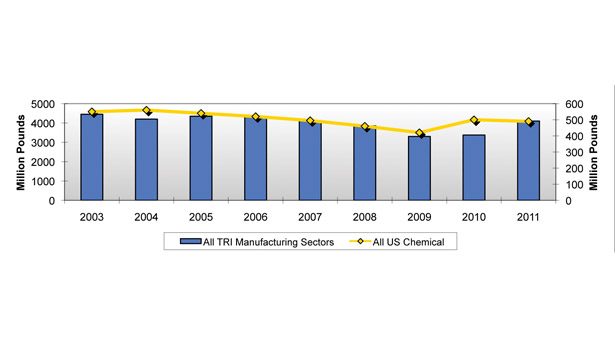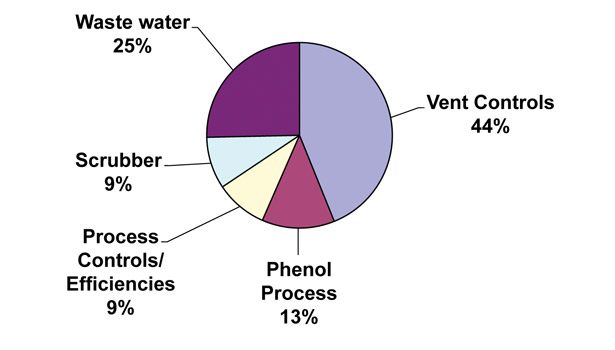"Environmentally friendly” can mean many different things. For Emerald Performance Materials—a mid-sized specialty chemicals company with four business
| Jump to: |
groups, eight manufacturing operations and sales to more than 70 countries across the globe—it has meant making a concerted effort to reduce emissions and consider ways to improve the chemical composition and volatile organic compound (VOC) levels of products.
Emerald is committed to reducing its environmental impact and takes seriously its responsibility to be a good steward of the communities in which the company operates and its employees live. Investments in research, manufacturing operations and infrastructure have reduced both emissions and energy consumption. Since the formation of the company in 2006, chemical emissions from Emerald’s operations have been reduced by more than 50% (see Figure 1).
Emerald has introduced more than 50 new products that offer customers lower or zero-VOC alternatives or 100% solids non-solvent options, thereby enabling customers to meet more stringent industry standards and end-market needs. Emerald has also focused efforts on developing and expanding product lines that provide greater environmental and health benefits than traditional alternatives. In the adhesives and sealants industry, for instance, Emerald is best known for its K-FLEX® brand of phthalate-free plasticizers from its Kalama Chemical business group. These materials have become a preferred choice due to favorable regulatory considerations, such as food contact clearances from the Food and Drug Administration (FDA), EU classifications and low VOCs, as well as an overall beneficial balance of performance properties in the application.1
Emerald also supplies EPALLOY™ specialty epoxy resins and Hypro™ reactive liquid polymers from the company’s CVC Thermoset Specialties business group, as well as a wide range of other specialty materials, including defoamers, colorants, antioxidants, accelerators, nitrile emulsions, specialty silicones, modifiers, aroma chemicals and antimicrobials. R&D teams in these other product areas have also focused on new technology and providing more choices of low- and zero-VOC alternatives.
Emissions Reduction
Chemical emissions data are highly scrutinized and easily accessed. Companies have been reporting their emissions data to the Environmental Protection Agency (EPA) for more than 25 years, and this information is now easily obtained from the Internet.2 In 1986, Congress enacted the Emergency Planning and Community Right to Know Act, followed four years later by the Pollution Prevention Act of 1990. One of the key facets of these acts mandates that the EPA collect data annually on the emissions of certain chemicals from industrial facilities and make the data available to the public through the Toxic Release Inventory (TRI) program.
Through its predecessor companies, Emerald has a long history in the chemical industry, with the oldest product lines dating back nearly 100 years. As a member of the Society of Chemical Manufacturers and Affiliates (SOCMA), Emerald is committed to high standards in safety, health and environmental responsibility. In particular, the company adheres to the standards established by SOCMA's ChemStewards® Program,3 as well as similar programs.
Emerald’s emissions reduction of more than 50% is especially significant when compared with the EPA’s industry-wide data gathered from across the country. Emissions have dropped significantly (from 25-75%) at nearly every Emerald location. In comparison, overall emissions reported to the EPA by U.S. chemical facilities have decreased 13% from 2003 to 2011, and emissions from all industries in the U.S. EPA’s database have dropped by 8% (see Figure 2).4
The reduction of emissions to date is the result of a combination of efforts made by Emerald’s leadership team, as well as investments the company has made to make improvements in health, safety and environmental (HS&E) impacts. The company has invested over $20 million in capital for projects aimed at improving HS&E impacts. This expenditure is in addition to investments made to expand the company’s capabilities, add capacity and complete acquisitions. While projects vary widely in scope across Emerald’s various business units, they are primarily aimed at eliminating or capturing waste streams and reusing them in some manner, either for the energy value or for reuse within the manufacturing process.
As shown in Figure 3, some of the more noteworthy projects that have resulted in Emerald Kalama Chemical’s ability to reduce emissions by 50% since its formation in 2006 (and nearly 70% over the past decade) include:
• Improvements in scrubbers, vacuum systems, tank vent controls and piping to return gases to the process
• Improved wastewater treatment systems, which reduce or capture gases from the biological degradation of organic wastes
• Process improvements and installation of additional controls to improve efficiencies, reducing emissions
• Reconfigured processes to eliminate the production of phenol byproducts
Beyond Emissions
The benefits of Emerald Kalama Chemical’s projects extend beyond the elimination of chemical emissions. The company has also achieved a reduction in its consumption of natural gas and wastewater generation by nearly 40%, and electricity consumption by more than 30%.
The company’s efforts to reduce emissions are not just focused in the U.S. When Emerald Kalama Chemical acquired its Rotterdam facility from DSM in 2010, it initially focused on wastewater improvements and reduction in particulates from the soot filter. Once fully implemented, however, the new steam generation system will have the most dominant impact in reducing air emissions. Emerald Kalama Chemical announced last year it had joined in a “green energy” initiative at its Rotterdam plant by signing 15-year agreements with both Rotterdam-based grid manager Stedin and energy supplier AVR. These agreements officially gave a green light to begin construction of a steam grid in the Rotterdam Botlek, which encompasses the region around the harbor. The grid is a part of the greater Rotterdam Climate Initiative Project, which has targeted a 50% reduction in carbon emissions by 2025 (as compared to its 1990 baseline).5
Emerald Kalama Chemical is the first steam consumer to sign on to the steam grid. The steam is produced in AVR’s Energy from Waste facility in Rotterdam-Botlek. Given the biogenic content of the waste that is used to produce the steam, the process is recognized as “green.” Since the signing of the agreement last year, the project is already underway and is projected for completion this month.
The concept for the construction of a steam network has been in existence for many years. The new grid does not rely on generating steam from fossil fuels. As a result, it will reduce the CO2 footprint considerably and improve air quality. Approximately 100 companies operate in the Port of Rotterdam because of its strategic access to the largest port in Europe. The grid relies on distributing steam from one plant to other plants nearby using a closed-loop system, rather than the current practice of having each plant produce its own steam from fossil fuel and discharging excess heat to the air and water. Plants located along the steam pipe route may either contribute or consume steam, according to their needs.
The entire steam network will reduce CO2 emissions by over 200,000 tons annually, according to Stedjin.6 Emerald anticipates that it will reduce its CO2 emissions by 30,000 tons annually as a result of the steam network. In addition, the steam condensate from Emerald’s operation will be returned to the network and will be used by AVR for heating homes in the region.
Responsible Growth
The company’s overall revenue has nearly doubled since its inception, and Emerald Kalama Chemical’s revenue has more than tripled. Such growth was achieved through both organic expansion and acquisition. Growth of this magnitude can often present challenges from an HS&E perspective as the company increases production. Edward Gotch, president of Emerald Kalama Chemical and member of the company’s executive office, has set the bar high to make sure plant expansions are designed to continually improve productivity, as well as HS&E performance metrics.
The company prides itself in finding creative solutions from a new product development perspective and has taken the same approach to finding ways to reduce emissions and improve productivity. Both engineers by training, Gotch and Brian Denison, vice president of operations for Emerald Kalama Chemical, continually challenge the team to find ways to increase productivity in every expansion project while also achieving a reduction in emissions. Prior to his current position, Denison held the position of corporate vice president of HS&E and president of Emerald Kalama Chemical BV.
Emerald Kalama Chemical has commissioned more than six capacity increases since the company’s inception. The company has also invested in the expansion of several product lines in its other business groups.
Product Development
New product development efforts have focused largely on creating environmentally friendly alternatives to traditional ingredients, such as high-VOC materials,
New product development efforts have focused largely on creating environmentally friendly alternatives to traditional ingredients, such as high-VOC materials, endocrine disruptors or materials classified as carcinogens. |
endocrine disruptors or materials classified as carcinogens. A more environmentally friendly alternative can mean many things to customers, depending on their manufacturing process, end application and targets. However, in general, customers have been concerned with VOCs and products that are free from a host of chemicals that have been deemed harmful in some manner and appear on various lists, such as IARC and ECHA.7 Some customers cite factors related to the lifecycle as important, while others put a priority on products that are readily biodegradable, made from renewable resources, or perhaps more durable and longer lasting.
New products from Emerald Performance Materials set the bar for high-performance, environmentally friendly resins and additives. The company’s objective has been to make sure to build in improvements that are more environmentally friendly while still delivering value.
Adhesives and sealants manufacturers are familiar with dibenzoate chemistry, the basis for the Kalama K-FLEX product line. Long before the phthalate concern came to light, many of them used these materials because of their superior performance. However, other applications have just recently turned to this chemistry because it offers an attractive alternative to phthalates and traditional high-VOC coalescents and provides benefits from a regulatory standpoint, as well as delivering key performance advantages. The growing popularity of the K-FLEX products has been one of the key drivers for growth in the Emerald Kalama Chemical business group.
Last year, Emerald Kalama Chemical dedicated its new global R&D center, which serves as a critical component in the company’s strategy to enhance abilities to develop new technology solutions and provide customer support. As a result of this and other investments, the company has accelerated its launch of new products, developing new technologies based on benzoate esters and filing four patent applications since 2011 for products used in a range of adhesives, coatings, sealants, caulk and vinyl applications.
For example, in coatings and graphic arts applications, customers are able to replace coalescents that were 100% VOC, such as 2,2,4–trimethyl–1,3–pentanediol monoisobutyrate (TMPDMIB) and assorted glycol ethers, with materials that are 2% VOC. New grades of dibenzoates have demonstrated excellent film formation, freeze-thaw resistance, improved scrub resistance and gloss in side-by-side testing vs. a range of other products ranging from traditional high-VOC coalescents, such as TMPDMIB, and other lower VOC coalescents.8,9 In the vinyl industry, new grades of high-solvating dibenzoates are an excellent alternative to butyl benzyl phthalate, or for blending with other general-purpose plasticizers to optimize properties such as durability, stain and extraction resistance.
Dibenzoate chemistry has been identified by the European Chemicals Agency (ECHA) as a safer, viable alternative to phthalate plasticizers. Many phthalates have been identified as “substances of very high concern” because of their persistent, bioaccumulative and toxic nature (PVB) or very persistent and very bioaccumulative nature (vPvB), coupled with wide dispersive uses or high volumes. The January 2009 ECHA report named dibenzoate plasticizers as an acceptable alternative, partially due to their biodegradability, indicating these materials as non-SVHC, non-PBT.
While dibenzoate esters are biodegradable by themselves, once formulated into the adhesive or sealant, the end products withstand all the normal performance challenges as well as, or better, than alternative systems. When formulated into adhesives and sealants, the K-FLEX plasticizers impart valued properties such as excellent minimum film formation temperature (MFFT) suppression and viscosity response, low VOCs, extended open times and reduced set times, improved wet tack, enhanced adhesion, and improved dried film resistance to oil and grease.10 These products are also compatible with a variety of polymers. Certain grades are cleared for use under FDA 21CFR 175.105, 21CFR176.170 and 21FDA 176.180—clearances that are important for many food packaging applications.
Other Highlights
For adhesives and sealants manufacturers making structural adhesives, 100% total solids systems can be an environmentally friendly alternative to solvent systems and traditional joining systems, such as mechanical fasteners and welds, which may become sites for corrosion. This is a key area of focus and growth for Emerald’s CVC Thermoset Specialties business group.
Performance of structural adhesives has improved, in part due to the availability of specialty, high-performance materials, in addition to improved methods of applying these types of liquid adhesives to optimize results. Customers have come to gain confidence over time, appreciating the impact that the use of structural adhesives and composite materials can have on performance, durability and extending the lifecycle of the end product. In coatings applications, a more durable coating can extend the time between repainting, with the associated potential savings on both materials and labor.
The performance benefits associated with using CVC’s materials to extend durability and product life are significant. Adhesives based on CVC’s EPALLOY specialty epoxy resins and modified resins with Hypro reactive liquid polymers (RLP) in the adhesive formulation can greatly enhance fractural toughness, impact resistance, low-temperature flexural modulus, T-peel and lap shear. Improvements ranging from a two- to 10-fold increase can be achieved with RLP modification over unmodified systems.
Coatings applications using specialty epoxy resins based on bisphenol-F and novolacs have been shown to significantly improve chemical resistance in inorganic solvents (e.g., sulfuric, nitric, chromic and hydrochloric) and organic solvents (e.g., toluene, xylene, benzene, kerosene and ethanol) over standard liquid epoxy resins. For example, a coating formulated using Epalloy 8240 withstood a 30-day immersion in sulfuric acid, while the standard liquid epoxy resin showed significant corrosion degradation after 24 hours.
CVC’s specialty materials also provide benefits in bonding composites. As a result, these materials have been growing in use over their heavier metal counterparts because they can be incorporated to reduce weight and fossil fuel use. The company continues to innovate, launching several new 100% total solids RLP products based on glycidyl, hydroxyl and methacrylate functionality. The functional groups enable reaction into the backbone of epoxy, acrylic, polyester, vinyl ester, PVC and urethane polymers. The company also recently launched ERISYS™ GE60, a sorbitol reactive monomer based on renewable ingredients, with multiple functional hydroxyl groups.
Emerald has developed many other new products for coatings, graphic arts and adhesives applications designed with environmentally friendly considerations. Recent examples include: LUCIDA COLORS™ energy curable low odor/high strength dispersions and Trans-oxides®; VERDIS™ zero-VOC, formaldehyde-free, APE-free dispersions and Trans-oxides for in-plant tinting; a range of new zero-VOC FOAM BLAST® products that have outstanding in-can stability for long-term foam control without sacrificing gloss; and newer Antarol™ defoamers made from renewable, non-petroleum-based vehicles.11
Sustainability Drives Innovation
At Emerald, the commitment to continuous improvement starts with the company’s leadership team but is also embraced throughout the organization. The investment in developing new products that are lower in VOCs or offer other environmentally friendly attributes (in addition to delivering performance benefits) has paid off by serving as a key driver of growth. The investments in process improvements have not only effectively reduced emissions, but also support a manufacturing infrastructure that is designed to produce high-quality products responsibly and reliably.
For additional information, contact the lead author at (330) 916-6726 or julie.vaughn@emeraldmaterials.com, or visit www.emeraldmaterials.com.
Listen to our podcast with Edward Gotch, president of Emerald Kalama Chemical!
Acknowledgements
We offer appreciation to the colleagues at Emerald who contributed to the paper, including Shamsi Gravel, William Arendt, Emily McBride, Huber Claassen, John Mol, Jeffrey Tyrrell and David Wolf, as well as to all our colleagues who have worked diligently to contribute to the successes in HS&E matters at the company.
References
1. Gravel, S., and McBride, E., “Dibenzoate Plasticizers Offer a Safe, Viable Alternatives to Phthalates,” Adhesives and Sealants Industry, February 2010, pp. 15-18.
2. Toxic Release Inventory, U.S. EPA, www.epa.gov/tri/tridata/.
3. “ChemStewards® Core Principles,” Society of Chemical Manufacturers & Affiliates, www.socma.com/ChemStewards/index.cfm?subSec=17.
4. “2011 Toxics Release Inventory National Analysis,” U.S. EPA, www.epa.gov/tri/tridata/tri11/nationalanalysis/index.htm, Figures 4 and 25.
5. “Mitigation: 50% Carbon Reduction in 2025,” Rotterdam Climate Initiative, www.rotterdamclimateinitiative.nl/EN/english_2011_design/50_reduction.
6. “Steam Pipe,” Rotterdam Climate Initiative, www.rotterdamclimateinitiative.nl/en/english_2011_design/50_reduction/projecten/steam_pipe?portfolio_id=65.
7. European Chemicals Agency, www.echa.europa.eu.
8. Arendt, W. and McBride, E., “New Dibenzoate Plasticizer/Coalescent Blend for Low VOC Coating Formulations,” Coatings Tech, 2011, 8, 26-33.
9. Arendt, W., Hanes, R., and McBride, E., “Advances in Low VOC Coalescent Technology,” Paints and Coatings Industry, August 2012.
10. Mc Bride, E., and Arendt, W., “Searching for a Better Dibenzoate Solution,” Adhesives and Sealants Industry,” January 2011, pp. 23-27.
11. Penny, T., “Foam Control Solutions that Meet Today’s Tighter Environmental Regulations,” Paint and Coatings Industry, August 2011.
To find suppliers of raw materials and other products, visit www.adhesivesmag.com/suppliers.






